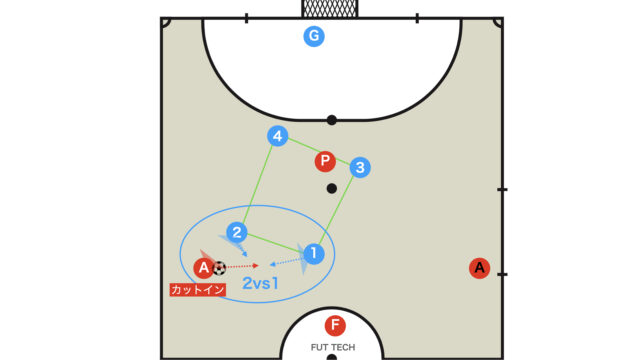Man-to-man DF is, as the name suggests, a very simple defensive tactic, but winning a futsal match using it in actual competitive play is not easy.
However, in reality, it is extensively used by representative teams with strong individual players, and it can be said to be a defensive tactic that has become a global trend.
This article provides an in-depth explanation of man-to-man DF in positional defence.
Why? Why is man-to-man DF trending?
As a fundamental defensive concept, constructing multiple lines is employed and remains widely used. A few years ago, tactics such as line cuts and volante—where players drop into rows—became the trend as methods to counter defenses built on multiple lines. In turn, man-to-man DF is thought to have made a comeback as a defensive tactic to counter these line cuts and volante.
Recently, block & continue (pick & roll) has become popular as a way to beat man-to-man DF.
- Principles of Man-to-Man
- Each Player Secures a Mark
- Position Yourself on the Straight Line Connecting the Opponent and the Goal (Opponent → You → Goal)
- Distance from the Opponent: Maintaining a Gap that Prevents Being Outflanked
- Body Orientation and Vision: Keeping Your Mark and the Ball in the Same Field of View
- Responding to an Opponent Who Breaks Free
- Block or Curtain → Mark Exchange
- When the 1st DF Can Join the Press: The DF Who Goes to Steal
- How to Recover the Defensive Organization When Beaten Individually
- Man-to-Man DF Against Other Formations
- Summary
Principles of Man-to-Man
Each Player Secures a Mark
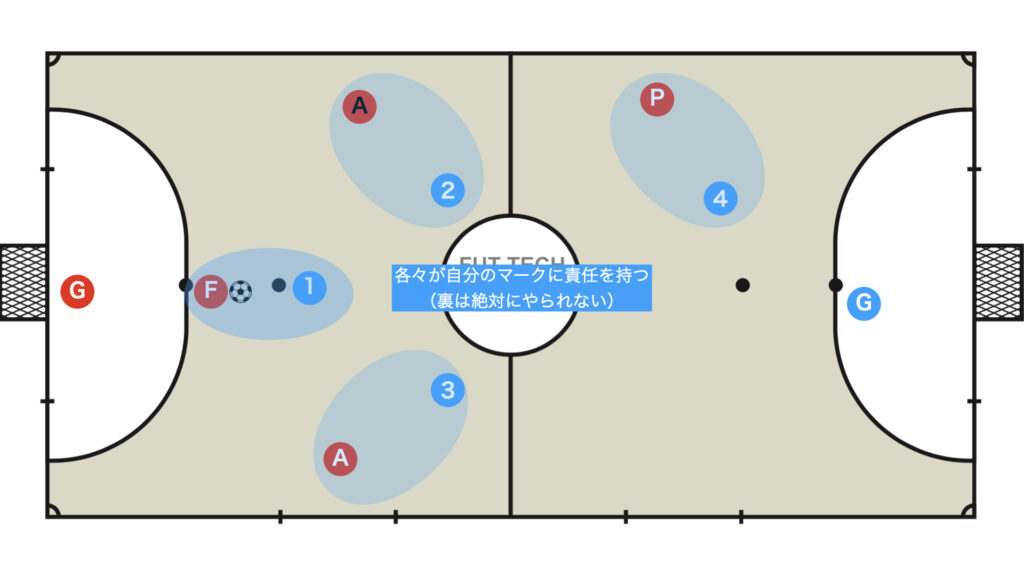
Each of the four FP players secures his own mark and takes responsibility for it.
Because man-to-man defense is based on the premise of not losing in one-on-one situations, it demands high individual ability.
Position Yourself on the Straight Line Connecting the Opponent and the Goal (Opponent → You → Goal)
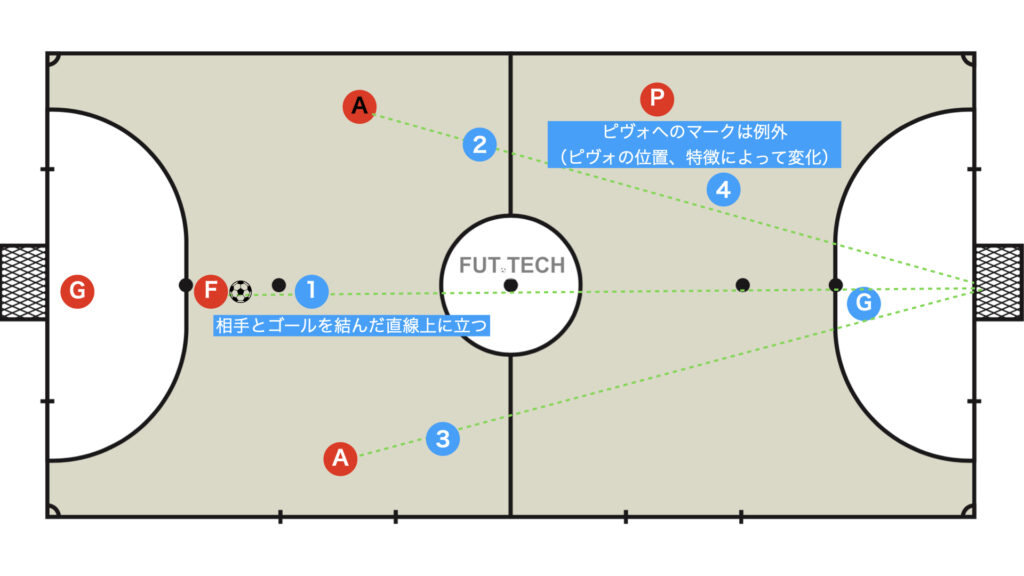
Since the primary principle is to protect the goal and avoid being beaten from behind, it is fundamental to position yourself in a straight line in the order of opponent, yourself, and goal.
However, when marking a non-ball-holding pivo, maintain a distance and angle that also consider interception.
Distance from the Opponent: Maintaining a Gap that Prevents Being Outflanked
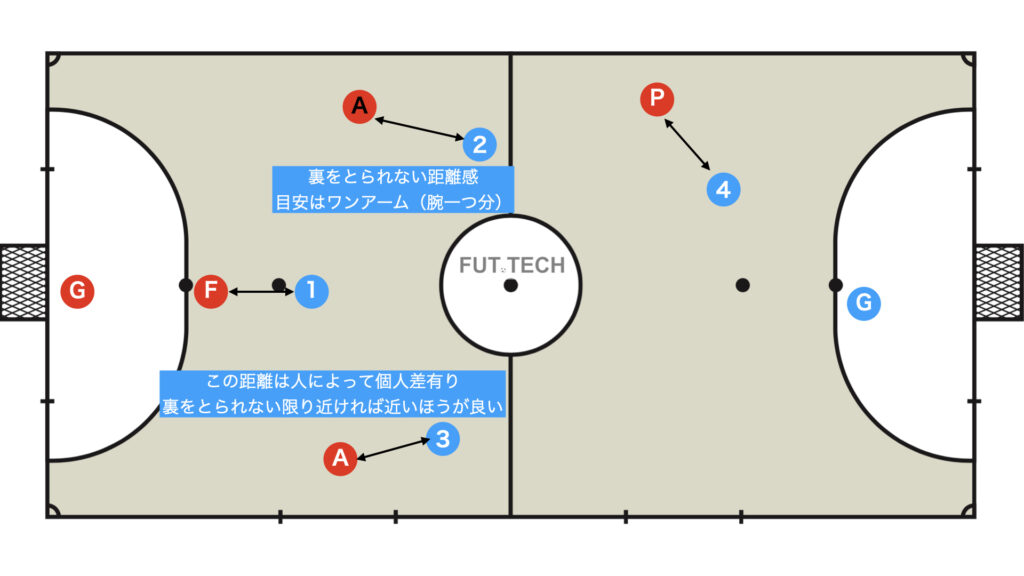
The gap required to prevent an opponent from getting behind varies from person to person (depending on individual ability), but it is said to be at least one arm’s length.
Bad Example
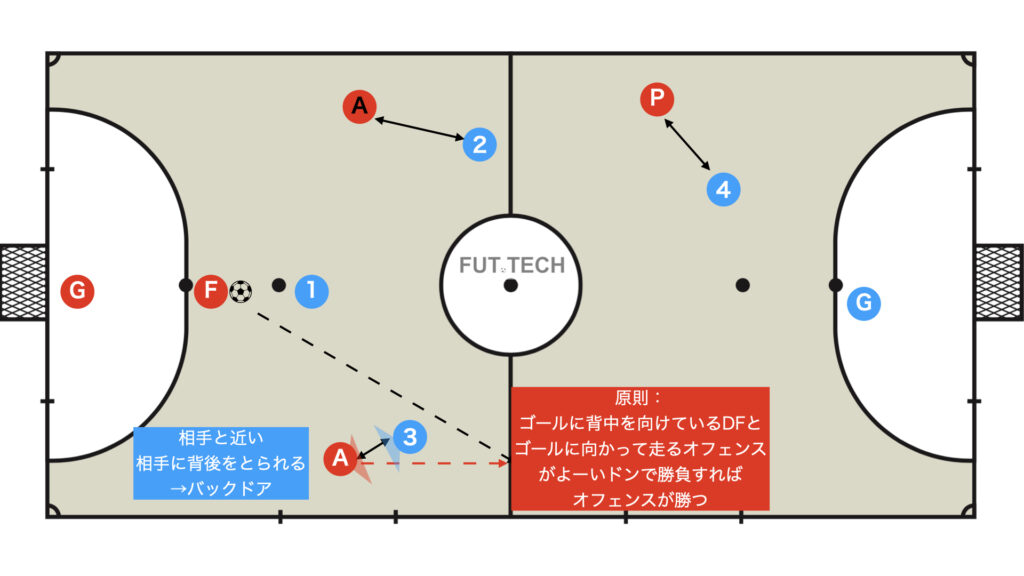
Even if you are positioned in the order of opponent, yourself, and goal, if the distance to the opponent is too narrow, it becomes easy for them to get behind you.
It is not about speed, but rather the positional advantage derived from whether you have your back turned to the goal or are facing it.
Body Orientation and Vision: Keeping Your Mark and the Ball in the Same Field of View

By always keeping both your mark and the ball in your field of vision, you can recognize the rapidly changing situation on the pitch; otherwise, defending in a man-to-man system is impossible.
Therefore, it is important to position yourself so that you can see both your mark and the ball—that is, by looking at the midpoint between the two, you become aware of the triangle formed by yourself, the ball, and your mark.
If you cannot keep both in your field of view, turning your head is essential.
There are individual differences, but it is said that the maximum angle of physical peripheral vision is 180 degrees, while the angle at which details can be clearly discerned is about 90 to 120 degrees.
It is recommended to hold your fingers to the left and right of your face in advance to understand your own field of vision.
Responding to an Opponent Who Breaks Free
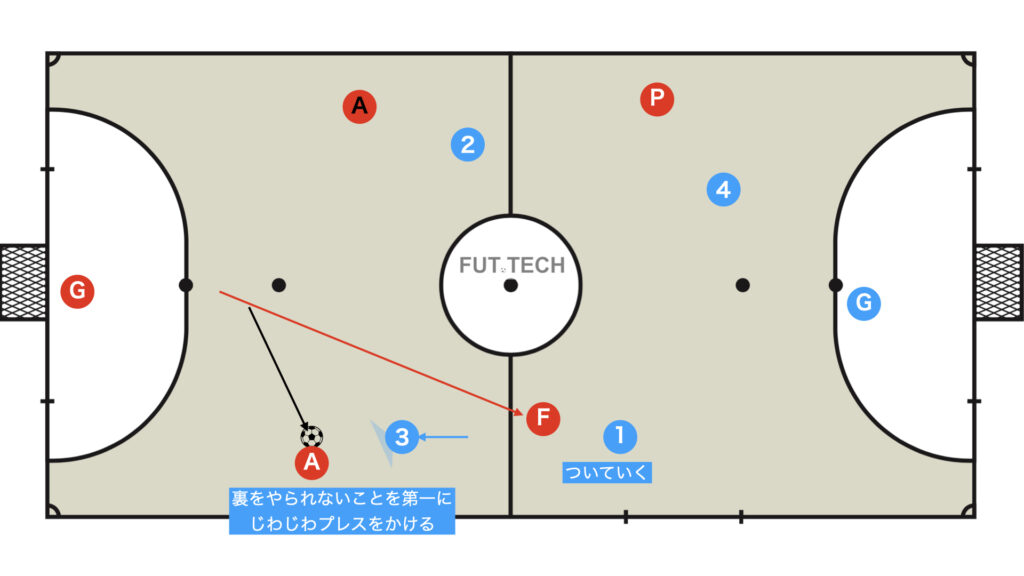
In man-to-man defense, marks are not exchanged; instead, you follow every opponent who breaks free.
Block or Curtain → Mark Exchange

If you do not perform a mark exchange in response to a block or curtain, the offense will succeed in breaking your mark as intended; therefore, exchanging marks is the safe option.
I sometimes hear arguments that if you exchange marks, it shouldn’t be called man-to-man DF. While it is true that it is not strictly man-to-man DF, in a broader sense it can be considered as such. In top-tier defense, there are hardly any examples of a rigid man-to-man DF that never exchanges marks, and it is fundamental to exchange marks flexibly.
When the 1st DF Can Join the Press: The DF Who Goes to Steal
Simply sticking with the opponent all the time will only drain your energy, so at some point you need to switch gears and go for the steal.
One guideline is that when the 1st DF is able to press—that is, when they can close in within a distance of less than one arm’s length—they should go for the steal.
Blocking the Passing Lane
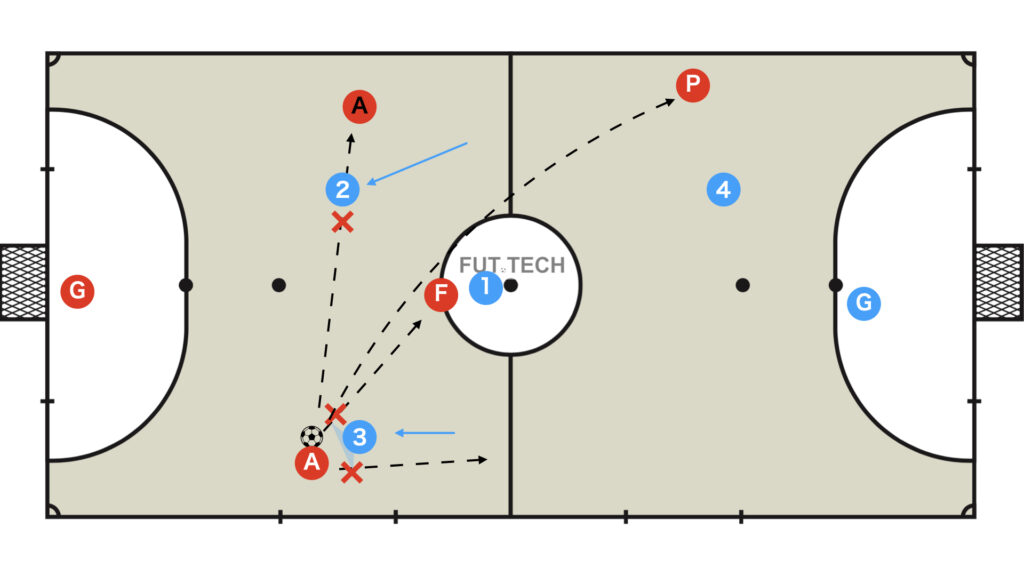
Normally, the player in blue number 2 must stand between his mark and the goal, but since the 1st DF can join the press, he goes to block the remaining passing lanes.
Double Team
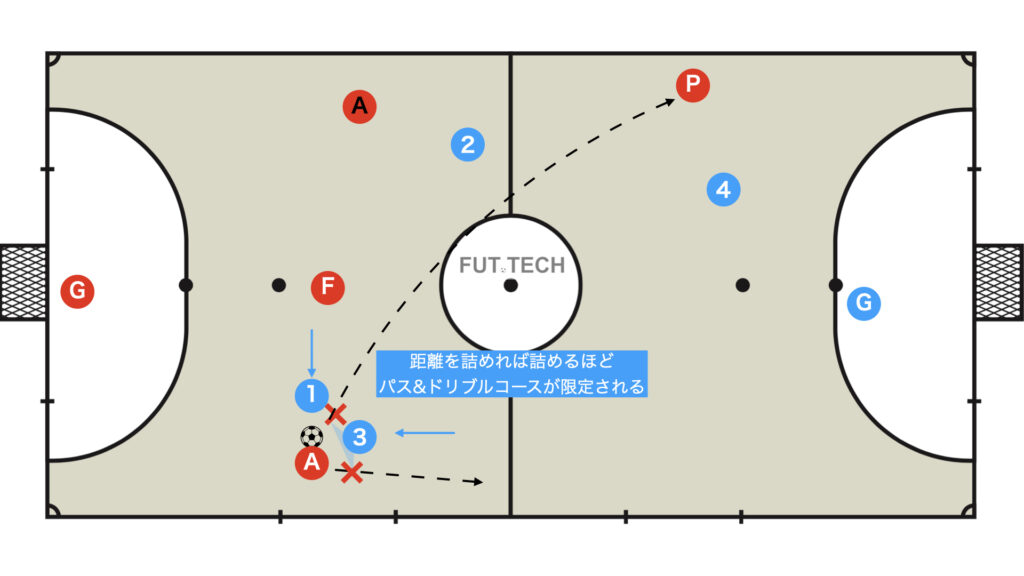
If the second DF is close enough, a double team that surrounds and goes for the steal is effective.
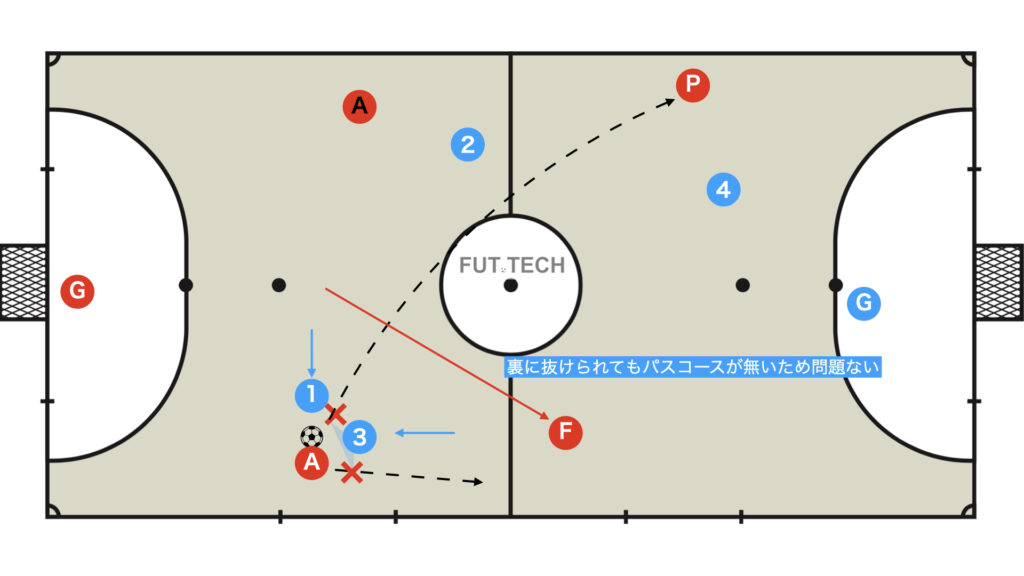
If the 1st DF has effectively cut off the passing lanes to the back and to the pivo, the opponent cannot pass there, so it is acceptable to abandon your own mark.
Double Team Against the Pivo
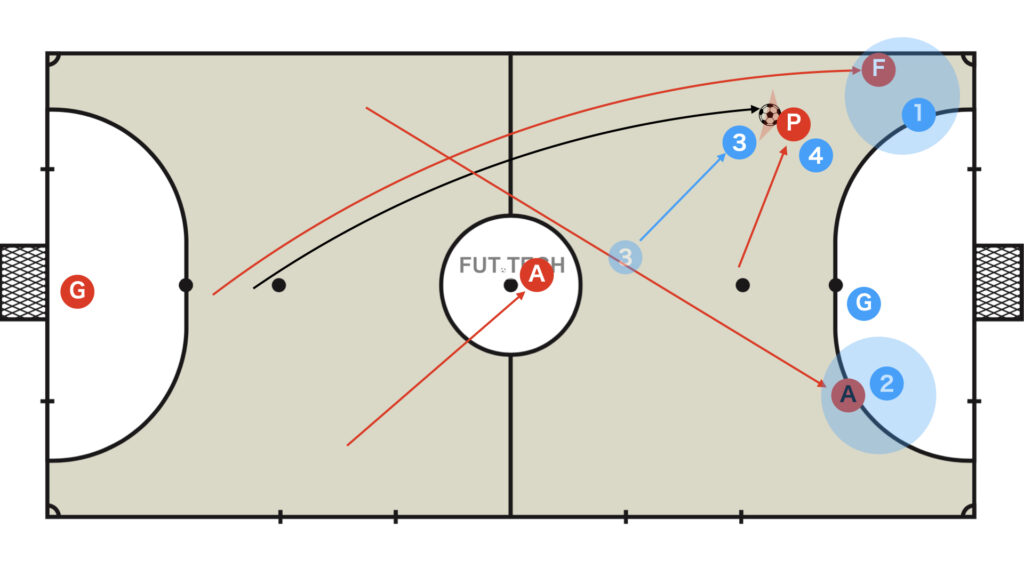
After the pivo is targeted, it is generally expected that everyone retreats to the ball line; however, the 4th DF (the one responsible for the opponent’s fixo) can abandon his mark and join in a double team on the pivo without issue.
How to Recover the Defensive Organization When Beaten Individually
Rotation

While man-to-man DF is based on the premise that you won’t lose in one-on-one situations, it is necessary to have a contingency plan for emergency situations in case your mark is stripped and you are beaten individually.
In a previous play’s man-to-man DF, if a breakthrough occurs through a one-two or paralela, the player who was marking the opponent’s pivo will adjust his position as shown in the figure.
In that case, since the pivo is left unmarked, the closest DF will retreat to take up the marking, and as a result, three or four players will each shift their marks and rotate.
Counter-attack Response

If the defensive rotation cannot keep up, it is advisable to respond similarly to a defensive transition.
In the diagram above, it results in a 1 vs 2 defensive transition, with the nearest player retreating to the weak side of the defense.

Professional Foul
It is essential to always have the option to stop the play with a foul as a last resort.
Since giving away a 6th foul results in a second penalty kick, it is necessary to keep the foul count in mind when making the decision.
Man-to-Man DF Against Other Formations
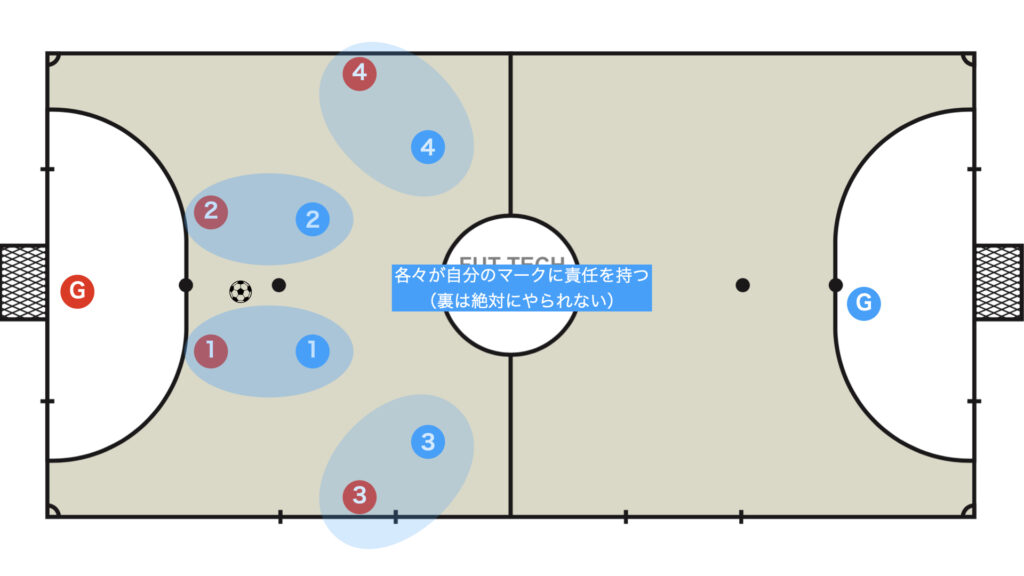
Man-to-man is effective not only against a 3-1 defense but also various defensive setups including 4-0.
However, if man-to-man is used against a quatro and the opponent is once allowed to get behind, there is a possibility that no one will be left to cover.
Therefore, it is very risky for amateurs to casually rely on man-to-man DF.
However, among European national teams, there are still a fair number of teams that use man-to-man DF even against a quatro.
Summary
What do you think?
While many may execute man-to-man without much thought, you might find that it is deeper than it seems.
Man-to-man defense is the foundation of all defensive tactics, and by first working on man-to-man DF, it becomes easier to branch into other defensive strategies.
Furthermore, during developmental stages, employing man-to-man DF makes sense from the perspective of individual development.
I hope this helps you appreciate the benefits of man-to-man DF, even if just a little.

Thank you very much for reading this article to the end.
If you found this article useful, please consider sharing it using the social media share buttons above.
We regularly share valuable insights on futsal tactics on Twitter, so if you haven’t followed us yet, we’d appreciate your support!
We are committed to raising the level of futsal in Japan by sharing high-quality information through discussions with individuals who have coaching experience in the F.League and overseas.
If you have any questions or notice any mistakes, feel free to leave a comment below.
We update our articles regularly, so if you’d like to keep reading, please bookmark our site or search for “FutTech”!
